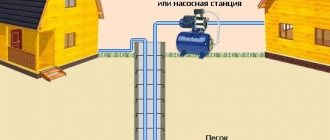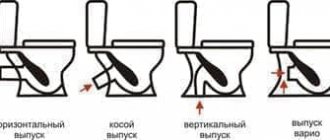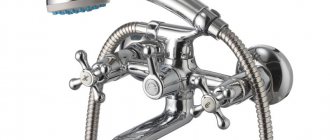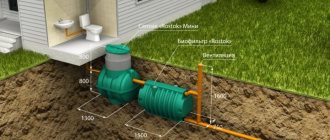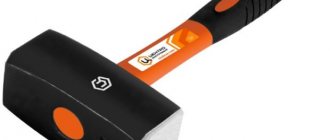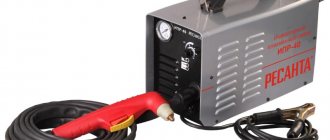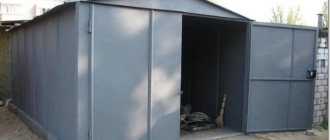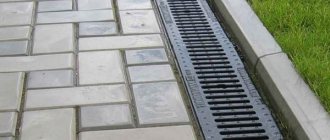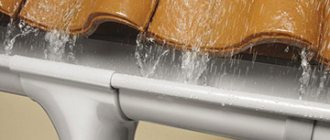Design features of the tool
A hammer consists of a handle and a head. All the force upon impact is transferred from the person’s hand to the head. It must have a strong connection to the handle. This is a prerequisite for work safety.
It is strictly forbidden to use hammers with a loose head or cracked handle.
The head structure consists of:
- Sock.
- Striker.
- Klina.
- Cheeks.
The toe is the back side of the head, which is wedge-shaped. It has a small area that absorbs the entire impact force. The toe of the hammer is used for crushing hard material and chasing. Some models of the instrument are equipped with a toe in the shape of a swallow's tail.
Expert opinion
Torsunov Pavel Maksimovich
The main striking part of the instrument is the striker. It has a shape of a relatively large area. An important characteristic of the striker is strength. In the process of work, he has to withstand a large number of blows of varying strength.
There is a hole on the head of the hammer, called “Vsad”. A handle is inserted into it. To ensure the strength of the connection of structural elements, an expansion of the entrance is made from the center upward. Some instrument models are equipped with a metal collar. Place it around the hole. The non-working, flat part of the milk is called the cheeks.
Material of manufacture
The classic version of the hammer has a cast metal head and a wooden handle. High strength steel is used to make the head.
It is produced in several ways:
- Casting.
- Forging.
- Milling.
Heads made of black steel are coated with a protective layer of zinc or polymer paint to prevent corrosion processes. To make the handle, hard wood is used: beech, hornbeam or oak. Some models of hammers are available entirely in metal, with a plastic or rubberized handle.
What should be the weight and size
The size and weight of the tool are among the main technical characteristics. They depend on the type of activity for which the hammer is intended. The weight of the tool determines the length of the handle. For a heavy tool it is 380-450 mm, for a light one – 200-260 mm. The cross section of the striker is determined by the weight of the hammer.
The standard section is considered:
- 15x15 mm – for lungs.
- 25x25 mm – for medium weight.
- 33x33 mm – for heavy ones.
Expert opinion
Torsunov Pavel Maksimovich
The heaviest hammer is called a sledgehammer. They are available in weights from 1 kg to 16 kg.
Device and characteristics
The tool consists of 2 main parts - the head and the handle.
The elements are connected as firmly as possible.
When an impact occurs, all the force is transferred to the head, and if it slips off the handle, it flies off a couple of tens of meters.
Therefore, it is prohibited to use a tool with a loose head or a cracked handle.
The head is made up of several parts:
• toe – the back side of almost all hammers is wedge-shaped.
In this case, the impact force is transferred to a small area.
Wedge blows are used to split hard materials during minting.
In some cases, the toe has an unconventional, rounded shape or is made in the form of a “dovetail”;
• striker – striking part.
It has a flat shape, a relatively large area, high strength and can withstand a large number of impacts.
The cross-section of the striker is square, rectangular or round;
• insertion – a hole for a handle, round or oval.
The landing increases from the center upward - this prevents slipping.
Some instruments have a metal collar around the end;
• cheek – the flat, non-working part of the hammer.
Material
The head is made from hard steel by injection molding, forging, and milling.
A product made of black steel is protected from corrosion by a layer of zinc or polymer paint.
Models made of titanium or copper do not need protection, just like hammers made of wood.
The steel head is hardened by electroinduction and strengthened.
The amount of hardening varies.
Thus, the toe is hardened to 36-42 units on the Rockwell scale, the landing - only to 24-30, the maximum hardness is given to the striker - up to 52 units.
The handle is most often made of hardwood - oak, beech, hornbeam.
However, models with plastic, rubberized or even steel handles are also offered - a welding hammer.
Dimensions and weight
These parameters are determined by the type of work performed.
Sizes include:
• handle length – determined by the weight of the tool.
The average length is 250–325 mm.
The length of the handle of heavy hammers is 380–450 mm, small ones – 200–260 mm;
• striker length – in light hammers it reaches 85–90 mm, in medium hammers – 115 mm, in heavy hammers – up to 135 mm;
• cross-section of the striker – is also determined by the mass.
In light hammers it is 15 * 15 mm, in medium ones - 25 * 25 mm, in large ones - 33 * 33 mm.
The weight of the tool varies widely: products for tool work weigh from 200 to 300 g, for metalwork – 400–500 g.
When repairing, heavy models are needed - 600–800 g.
Products weighing from 1 to 16 kg are called sledgehammers, and are used for breaking walls.
Kinds
What material is your hammer handle made of?
WoodMetal/Plastic
The main classification of a tool is its division into areas of activity. According to their purpose, hammers are divided into:
- Locksmith . Used in everyday life and professional activities. the latter are produced weighing up to 2 kg. The head is wedge-shaped, the firing pin is slightly rounded or flat. The handle is made of wood or rubber.
- Carpentry . Produced only with a flat striker. The wedge-shaped side of the head is shaped like a nail puller.
- Plotnitsky . The back of the head has the shape of a swallow's tail. The firing pin is made corrugated or flat. In some models it is specially magnetized to hold the nail. The nail puller-shaped nose can have an angle of inclination from 0 to 120 degrees.
- Roofing . Used for the construction of soft and hard roofs.
- Mallet . Used when working with tin or sheet metal. Material: cast rubber, wood or cast rubber. There are carpenter's and metalworker's mallets. The first type of instrument has a cylindrical or barrel-shaped head. In the plumbing version it is wedge-shaped.
- Pickaxe . The tool is intended for masons. The hardness of the head is not inferior to that of a forge hammer. Notches are made on the handle in the shape of a ruler. The flat part has a small cross-section, the back side of the head is pointed.
- Straightening . Used during body work to level out dents.
- Sledgehammer . The tool has a conical shaped insert. Used for strength work.
Rating
Each type of hammer has products that can be called the best. When evaluating a tool, technical characteristics, cost and performance properties are taken into account.
Sledgehammers
KAPRIOL 12301
Easy-to-use steel sledgehammer with fiberglass handle. Product weight 3 kg. Handle length – 90 cm. The connection between the head and the handle is epoxy. The KAPRIOL firing pin has a square shape, ensuring accuracy of impact. Manufacturer's warranty – 6 months.
Advantages:
- Comfortable handle.
- Strong connection of elements.
The disadvantages include the high price of the tool.
Leonid S. review:
Reliable sledgehammer. Very comfortable handle. It fits well in the hand.
FIT 45232
The Canadian brand has a distinctive yellow and black handle. Produced in China. Refers to a professional instrument. The length of the fiberglass handle is 800 cm. The firing pin is made of high-strength steel. It has a square shape. Product weight 4 kg.
Advantages:
- Weight.
- Reliability.
- Long service life.
The main disadvantage is the high cost.
Dmitry G. review:
A beautiful, reliable sledgehammer. I used it for more than 2 years at the dacha to drive pipes into the ground. Never let me down.
Locksmith
Inforce 59035
The tool has a very thoughtful design. Product weight – 500 g. The handle is equipped with a fiberglass coating. Has indentations for fingers. howl coating. The hardness of the striker is 10% higher than the requirements of the DIN standard. The method of fastening the elements is injection gluing with epoxy resin.
Advantages:
- Comfortable rubberized handle.
- Increased reliability.
- Low price.
The main disadvantage is insufficient weight for certain types of work.
Andrey F. review:
Reliable tool. When working, you can feel the shock absorption in your hand.
Delo Techniki 315100 DT/24/6
A weighted hammer that can be used to hammer nails very quickly. 45 steel is used to make the striker. The handle has a rubberized design. This ensures work safety.
Advantages:
- Low cost.
- Reliability of the design.
- Weight.
deficiencies identified.
Yuri M. reviews:
The hammer does not have a very attractive appearance. This deficiency does not affect performance.
Pickaxes
BISON MASTER 2015-05_z01
The hammer cannot be called a full-fledged pickaxe due to its low weight. Product weight 500 g. The firing pin has increased strength. Made of steel 55. The handle is made of wood, which is considered a minus of the product.
Advantages:
- Increased head strength.
- Low price.
The disadvantage is the material used to make the handle.
Sergey Kh. review:
The striker is made of good steel. Excellent at splitting any type of brick.
Sturm 1010-05-600
The hammer is equipped with a striker made of high-strength steel. Pickaxe weight 600 g. The handle is two-component. The surface of the steel base is covered with a fiberglass lining. There are three finger grooves. This improves safety and makes the handle more comfortable.
Advantages:
- Comfortable handle.
- Long service life.
- Ability to withstand heavy loads.
The disadvantage is the high cost.
Mikhail H. review:
Durable tool. The head does not deform under heavy loads.
Carpentry
Stanley FMHT1-51276
The hammer head is shaped like a straight nailer. It is equipped with a striker with a hardened surface and a protective coating. The vibration of the tool during operation is softened thanks to a special lining on the handle.
Advantages:
- Increased striker strength.
- Ergonomics.
The disadvantage of the tool is its high cost.
Dmitry I. review:
A very reliable and easy to use tool. Never let me down at work.
NEO 25-000
The hammer is made of a monolithic steel billet. This provides the structure with increased strength. Product weight 450 g. The handle is two-component. A special coating prevents your hand from slipping.
Advantages:
- Long service life.
- Light weight.
- Ease of use.
- Increased strength.
A disadvantage is considered to be poorly adjusted instrument balancing.
Vasily U. review:
The hammer has an excellent striker and a comfortable handle. I use the tool regularly. No deformation.
Straightening
ONNESWAY M10110
The hammer is very popular among car mechanics. The tool head has a rounded striker. The second side is made in the shape of a peak. The handle is extended. The design allows you to perform a wide range of work.
Advantages:
- Comfortable long handle.
- Wide functionality.
The main disadvantage is the high price.
Nikolay N. review:
I have been using a hammer in my work for over 10 years. Great tool.
KING TONY 7842-28
Multifunctional model. The hammer is used not only by bodybuilders, but also by installers, mechanics and carpenters. Walnut wood is used to make the handle. The tool is lightweight.
Advantages:
- Ease of use.
- Wide functionality.
- Low price.
The big minus is the rapid wear of the striker.
Vitaly R. review:
The hammer has replaceable polyurethane attachments. This allows you to perform various types of work, which is important when repairing a car body.
TYPES AND MAIN SIZES
1.1. Hammers must be made of the following types:
1 - with a round striker;
2 - with a square striker;
3 - with a round striker and a spherical toe.
1.2. The main dimensions of type 1 hammers must correspond to those indicated in Fig. 1 and in table. 1, type 2 - to hell. 2 and in table. 2, type 3 - to hell. 3 and in table. 3.
Type 1
1
- hammer head;
2
— handle;
3
- wedge
Crap. 1
Table 1
Dimensions, mm
| Type 1 hammer designations | Applicability | Nominal weight of hammer heads, kg | L | H | C , no more | |||
| with handle version 1 | with handle version 2 | with handle version 3 | Nom. | Prev. off | ||||
| 7850-0101 | 7850-0107 | — | 0,20 | 250 | ±2,5 | 80 | 1 | |
| 7850-0102 | — | 7850-0108 | 0,40 | 320 | ±3,0 | 100 | 2 | |
| 7850-0103 | — | 7850-0109 | 0,50 | 105 | ||||
| 7850-0104 | — | 7850-0111 | 0,60 | 360 | 110 | |||
| 7850-0105 | — | 7850-0112 | 0,80 | 120 | ||||
| 7850-0106 | — | 7850-0113 | 1,00 | 400 | 130 | |||
| 7850-0145 | 7850-0146 | — | 0,10 | 250 | ±2,5 | 70 | 1 | |
An example of a symbol for a type 1 hammer with a handle of type 1, a head weighing 0.20 kg, with a zinc coating 15 microns thick, chromated:
Hammer 7850-0101 Ts 15.hr GOST 2310-77
Type 2
1
- hammer head;
2
— handle;
3
- wedge
Crap. 2
table 2
Dimensions, mm
| Type 2 hammer designations | Applicability | Nominal weight of hammer heads, kg | L | H | C , no more | |||
| with handle version 1 | with handle version 2 | with handle version 3 | Nom. | Prev. off | ||||
| 7850-0114 | 7850-0123 | — | 0,05 | 200 | ±2,5 | 75 | 1 | |
| 7850-0115 | 7850-0124 | — | 0,10 | 250 | 82 | |||
| 7850-0116 | 7850-0125 | — | 0,20 | 95 | ||||
| 7850-0147 | — | — | 0,30 | |||||
| 7850-0117 | — | 7850-0126 | 0,40 | 320 | ±3,0 | 112 | 2 | |
| 7850-0118 | — | 7850-0127 | 0,50 | 320 | 118 | |||
| 7850-0119 | — | 7850-0128 | 0,60 | 360 | 122 | |||
| 7850-0121 | — | 7850-0129 | 0,80 | 130 | ||||
| 7850-0122 | — | 7850-0131 | 1,00 | 400 | 135 | |||
An example of a symbol for a type 2 hammer with a handle of type 1, a head weighing 0.20 kg, with a zinc coating 15 microns thick, chromated:
Hammer 7850-0116 Ts 15.hr GOST 2310-77
Type 3
1
- hammer head;
2
— handle;
3
- wedge
Crap. 3
Table 3
Dimensions, mm
| Type 3 hammer designations | Applicability | Nominal weight of hammer heads, kg | L | H | C , no more | |||
| with handle version 1 | with handle version 2 | with handle version 3 | Nom. | Prev. off | ||||
| 7850-0132 | 7850-0138 | — | 0,20 | 250 | ±2,5 | 82 | 1 | |
| 7850-0133 | — | 7850-0139 | 0,40 | 320 | ±3,0 | 95 | 2 | |
| 7850-0134 | — | 7850-0141 | 0,50 | 104 | ||||
| 7850-0135 | — | 7850-0142 | 0,60 | 360 | 118 | |||
| 7850-0136 | — | 7850-0143 | 0,80 | 130 | ||||
| 7850-0137 | — | 7850-0144 | 1,00 | 400 | 150 | |||
An example of a symbol for a type 3 hammer with a handle of type 1, a head weighing 0.20 kg, with a zinc coating 15 microns thick, chromated:
Hammer 7850-0132 Ts 15.hr GOST 2310-77
1.3. The main dimensions of hammer heads (item 1) of type 1 must correspond to those indicated in Fig. 4 and in table. 4; type 2 - to hell. 5 and in table. 5; type 3 - to hell. 6 and in table. 6.
Type 1
Crap. 4
Table 4
Dimensions, mm
| Type 1 hammer head designations | Nominal weight of hammer heads, kg | N | L | L 1 | D | B | b | h | r | r 1 |
| 7850-0101/001 | 0,20 | 80 | 25 | 21 | 20 | 26 | 10 | 18,0 | 190 | 2,5 |
| 7850-0102/001 | 0,40 | 100 | 31 | 26 | 26 | 34 | 14 | 25,0 | 225 | 3,0 |
| 7850-0103/001 | 0,50 | 105 | 36 | 30 | 28 | 37 | 240 | |||
| 7850-0104/001 | 0,60 | 110 | 37 | 30 | 40 | 15 | 26,5 | 250 | 3,5 | |
| 7850-0105/001 | 0,80 | 120 | 41 | 33 | 32 | 43 | 16 | 28,0 | 265 | |
| 7850-0106/001 | 1,00 | 130 | 42 | 34 | 34 | 45 | 17 | 30,0 | 280 | |
| 7850-0145/001 | 0,10 | 70 | 20 | 16 | 16 | 22 | 9 | 16,0 | 160 | 2,5 |
An example of a symbol for a type 1 hammer head, weighing 0.20 kg, with a zinc coating 15 microns thick, chromated:
Hammer head 7850-0101/001 Ts 15.hr GOST 2310-77
Type 2
Crap. 5
Table 5
Dimensions, mm
| Type 2 hammer head designations | Nominal weight of hammer heads, kg | N | B | h | b | r | r 1 |
| 7850-0114/001 | 0,05 | 75 | 11 | 12,5 | 7 | 145 | 1,00 |
| 7850-0115/001 | 0,10 | 82 | 15 | 16,0 | 9 | 160 | 1,20 |
| 7850-0116/001 | 0,20 | 95 | 19 | 18,0 | 10 | 190 | 1,75 |
| 7850-0147/001 | 0,30 | ||||||
| 7850-0117/001 | 0,40 | 112 | 25 | 25,0 | 14 | 225 | 2,50 |
| 7850-0118/001 | 0,50 | 118 | 27 | 250 | |||
| 7850-0119/001 | 0,60 | 122 | 29 | 26,5 | 15 | 3,00 | |
| 7850-0121/001 | 0,80 | 130 | 33 | 28,0 | 16 | 265 | |
| 7850-0122/001 | 1,00 | 135 | 36 | 30,0 | 17 | 280 | 3,50 |
An example of a symbol for a type 2 hammer head, weighing 0.20 kg, with a zinc coating 15 microns thick, chromated:
Hammer head 7850-0116/001 Ts 15.hr GOST 2310-77
Type 3
Crap. 6
Table 6
Dimensions, mm
| Type 3 hammer head designations | Nominal weight of hammer heads, kg | H | B | L | D | D 1 | h | b | r |
| 7850-0132/001 | 0,20 | 78 | 26 | 25 | 20 | 20 | 18,0 | 10 | 190 |
| 7850-0133/001 | 0,40 | 98 | 34 | 31 | 26 | 24 | 25,0 | 14 | 225 |
| 7850-0134/001 | 0,50 | 102 | 37 | 36 | 28 | 26 | 25,0 | 14 | 240 |
| 7850-0135/001 | 0,60 | 108 | 40 | 37 | 30 | 28 | 26,5 | 15 | 250 |
| 7850-0136/001 | 0,80 | 115 | 43 | 41 | 32 | 30 | 28,0 | 16 | 265 |
| 7850-0137/001 | 1,00 | 125 | 45 | 41 | 34 | 34 | 30,0 | 17 | 280 |
An example of a symbol for a type 3 hammer head, weighing 0.20 kg, with a zinc coating 15 microns thick, chromated:
Hammer head 7850-0132/001 Ts 15.hr GOST 2310-77
1.2, 1.3. (Changed edition, Amendment No. 4).
1.4. Maximum deviations in the dimensions of hammer heads are no more than class 2 according to GOST 7505, and the requirements of clause 2.4 of this standard must be met.
1.5. The main dimensions of the handles (item 2) must correspond to those indicated in the drawing. 7 and in table. 7.
Crap. 7
Note. It is possible to manufacture handles of other ergonomically convenient shapes.
Table 7
Dimensions, mm
| Handle designations | Nominal weight of hammer heads, kg | L | l | l 1 | l 2 | l 3 | H | H 1 | ||
| version 1 | performance 2 | performance 3 | ||||||||
| 7850-0114/002 | 7850-0123/002 | — | 0,05 | 200 | 165 | 130 | — | — | 13,5 | 20,5 |
| 7850-0115/002 | 7850-0124/002 | — | 0,10 | 250 | 200 | 150 | — | — | 17,0 | 23,0 |
| 7850-0116/002 | 7850-0125/002 | — | 0,20 | 190 | 145 | — | — | 19,0 | 27,0 | |
| 7850-0147/002 | — | — | 0,30 | — | — | |||||
| 7850-0117/002 | — | 7850-0126/002 | 0,40 | 320 | 250 | 200 | 110 | 40 | 26,5 | 34,0 |
| 7850-0118/002 | — | 7850-0127/002 | 0,50 | |||||||
| 7850-0119/002 | — | 7850-0128/002 | 0,60 | 360 | 275 | 220 | 120 | 50 | 28,0 | 36,5 |
| 7850-0121/002 | — | 7850-0129/002 | 0,80 | 30,0 | 39,0 | |||||
| 7850-0122/002 | — | 7850-0131/002 | 1,00 | 400 | 320 | 230 | 130 | 60 | 32,0 | 41,0 |
| Handle designations | H 2 | H 3 | H 4 | B | B 1 | B 2 | B 3 | B 4 | B 5 | ||
| version 1 | performance 2 | performance 3 | |||||||||
| 7850-0114/002 | 7850-0123/002 | — | 18,0 | 14,5 | — | 8,0 | 15 | 11 | 9,0 | — | — |
| 7850-0115/002 | 7850-0124/002 | — | 20,5 | 18,5 | — | 10,0 | 16 | 15 | 11,0 | — | — |
| 7850-0116/002 | 7850-0125/002 | — | 24,0 | 21,5 | — | 11,0 | 19 | 16 | 13,0 | — | — |
| 7850-0147/002 | — | — | — | — | — | ||||||
| 7850-0117/002 | — | 7850-0126/002 | 32,0 | 28,0 | 30 | 15,5 | 23 | 19 | 16,5 | 20 | 23 |
| 7850-0118/002 | — | 7850-0127/002 | |||||||||
| 7850-0119/002 | — | 7850-0128/002 | 34,0 | 30,0 | 32 | 16,5 | 25 | 23 | 18,0 | 21 | 25 |
| 7850-0121/002 | — | 7850-0129/002 | 36,0 | 32,0 | 34 | 18,0 | 27 | 24 | 19,0 | 23 | 27 |
| 7850-0122/002 | — | 7850-0131/002 | 41,0 | 34,0 | 36 | 19,0 | 28 | 28 | 23,0 | 24 | 28 |
(Amendment, IUS 12-2005).
An example of a designation for a handle of version 1 for a hammer head weighing 0.20 kg:
Handle 7850-0116/002 GOST 2310-77
(Changed edition, Amendment No. 4).
1.6. Maximum deviations of handle sizes are according to the 18th grade of GOST 6449.1.
1.2 — 1.6. (Changed edition, Amendment No. 1).
1.7. The design and dimensions of the hammers and wedge parts are indicated in the appendix.
How to choose?
The choice of tool depends on the type of work for which it is intended.
It is important to pay attention to:
- Safety.
- Execution material.
- Functional.
- Weight and size.
Hammers with a durable construction and a handle equipped with a fiberglass lining are considered the safest. It prevents your hand from slipping while working. You need to choose a tool based on your anthropometric data.
How to choose a hammer
It seems that choosing a hammer is not such a problem. In fact, there are a lot of nuances that you should pay attention to during the purchasing process. When choosing a tool for a certain type of work, you need to evaluate the following factors:
- Depending on the functional features, each option has a different type of impact part. Therefore, you need to decide exactly what type of work you need the tool for.
- You need to carefully inspect the handle for chips and more complex damage. A high-quality tool will have a perfectly smooth and dense handle, regardless of what material it is made of.
- Much depends on the design. For example, a steel hammer is made entirely of steel. Therefore, the handle must have appropriate extensions at the head and at the end of the handle. A special coating is provided that will provide a good grip. If the design does not meet such conditions, then the tool will give a huge recoil or vibrate upon impact.
- A heavy tool should have the thickest and longest handle possible. Normally, the length is 38-45 cm. When the length of the handle is shorter, there is a risk of serious injury due to a fracture of the base of the handle during operation.
- The next factor will be the weight of the tool. For everyday use, it is enough to have a hammer weighing 350-450 g. If you need to carry out more serious construction or repair work (dismantling walls, roof repairs), then the weight of the device should be 0.6 - 0.8 kg.
- The requirements for the head in terms of fastening are the most important. The metal part should fit tightly on the handle, not move, deform, or dangle. This aspect can be checked directly during the purchase process by making a few steps.
Choosing is not so difficult if you know and take into account all the nuances during the purchase. You need to pay attention to the structure and fastenings of the tool, its capabilities and functionality.
Working with the tool
- Before starting work, you should always check the strength of the connection of structural elements. There should be no cracks or chips on the handle. Hammers that have defects are unreliable and dangerous to operate.
- When working, you need to hold the hammer by the middle of the handle or higher. This increases efficiency and ensures safety.
- The side surface of the head must not be used to drive nails. This could lead to its split.
- The force when working with milk should be distributed throughout the entire arm, and not just on the hand and palm.
- The material being hammered must always be on a solid base.
Adviсe
- When working with a sledgehammer, you need to wear eye and ear protection. Splinters flying off from the material being processed can cause injury to a person. After working for long periods of time, workers may experience ringing in the ears.
- You can use cardboard to hold the nail while driving. This will save your fingers from a possible hammer blow.
- In order to soften the blow of the hammer, a piece of a tennis ball is placed on the head of the tool. This need often arises when assembling furniture.
CONTROL AND TEST METHODS
4.1. The dimensions and roughness of surfaces are controlled by universal or special measuring instruments.
4.2. The hardness of the working parts of the hammer is checked according to GOST 9013.
4.3. The quality of galvanic coatings is controlled according to GOST 9.301, paint coatings - according to GOST 9.032.
4.4. The appearance of protective and decorative coatings is checked by inspection.
4.5. The strength of the connection between the hammer head and the handle is tested by uniformly increasing load with the forces specified in clause 2.13. The load is applied in the direction of the axis of the hammer handle and controlled with a dynamometer or calibrated load, while displacement of the hammer head relative to the handle is not allowed.
(Changed edition, Amendment No. 3).
4.6. The strength of hammers is determined by three times a strong shoulder blow on a steel plate with a thickness of at least 5 mm placed on an anvil, heat-treated to a hardness of 34 ... 41.5 HRCe.
After testing, all parts of the hammers should be free of cracks, chips, kinks, and dents.
4.7. The moisture content of wood handles is measured according to GOST 16588 or with a moisture meter according to GOST 29027.
(Introduced
additionally, Amendment No. 1 ).
